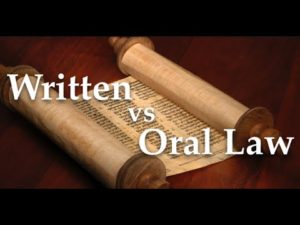Written and Oral Torah
 Lawrence H. Schiffman, From Text to Tradition, Ktav Publishing House, Hoboken, NJ, 1991.
Lawrence H. Schiffman, From Text to Tradition, Ktav Publishing House, Hoboken, NJ, 1991.
One of the basic premises on which the tradition of the tannaim was based was the concept of the two Torahs, oral and written, which, the rabbis believed, had been given by God to Moses on Sinai. According to the rabbinic view, the two Torahs were complementary. The oral Torah provided the interpretations and explanations which made possible the application of the written Torah as a way of life. Therefore, the two Torahs were of equal status and authority with one another. Further, the accuracy of the transmission of the teachings of both Torahs was seen to depend not only on the correctness of the contents, but also upon the mode of transmission. The tannaim make clear that to be considered authentic, a tradition must be transmitted in the same way it was given at Sinai. Therefore, the written Torah had to be taught from a scroll, and the oral law had to be recited orally by a tanna.
The history of the oral law concept is complex. Its earliest attestation is found in Josephus. He asserts that the Pharisees possessed ancient traditions which they had inherited from past generations. These traditions, combined with ancient customary law as well as with the emerging midrashic exegesis which was developing in the Second Temple period, provided the basic content of what the rabbis later called the oral law. At some point between the late first century B.C.E. and the first century C.E., the notion began to be expressed that the oral law, along with the written, had been given at Sinai. This development has been explained by some modern scholars as the result of a desire on the part of the Yavnean rabbinic authorities to solidify their authority by claiming divine origin for their own traditions. Actually, however, such ideas were developing naturally as the various approaches to Judaism in the Second Temple period strove to provide the written law with an appropriate supplement to make it possible for the Torah to serve as a genuine way of life in the Greco-Roman period. In Pharisaic Rabbinic Judaism, this was accomplished by the oral law.
This idea allowed Pharisaic Judaism, and, later, the rabbinic tradition, to develop organically. It provided the basis for the assertion of continuity in Talmudic Judaism, an assertion maintained even in the face of numerous adaptations and adjustments, for in the view of the rabbis there had been no changes—all later developments had already been commanded as part of the Sinaitic revelation.
Talmudic tradition has always assumed that the notion that two Torahs were given on Sinai went all the way back in time. Modern scholars have come to question this assumption. In any case, firm evidence shows that the concept was fully developed by the aftermath of the revolt. By that time, appeals to the Sinaitic origin of laws were made, although the notion of a dual Torah and dual revelation was not nearly as evident as one might expect. Clearly, then, the idea was developing in Pharisaic times, and the unwritten laws of the fathers were an earlier stage in its development. The concept became more important in the period leading up to the destruction. In the difficult years after the revolt, when the support of the people at large (the ‘am ha-‘ares) was so important, the rabbis, in order to guarantee the authority of their teachings, occasionally appealed to the divine origin and nature of the oral law. It was only in amoraic times, however, that the full midrashic basis for these ideas was worked out, with the rabbis asserting that the oral Torah and its authority were mentioned in the written law. In this case, though, the transition cannot be understood as the result of external political influences. It resulted from an organic trend in Judaism which developed in a manner consistent with the needs of the times. Indeed, this is the manner of most developments and changes in Judaism, the unique contribution of the Pharisaic heritage.



